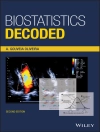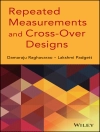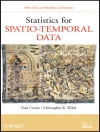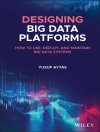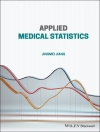Praise for the First Edition
‘The obvious enthusiasm of Myers, Montgomery, and Vining and
their reliance on their many examples as a major focus of their
pedagogy make Generalized Linear Models a joy to read. Every
statistician working in any area of applied science should buy it
and experience the excitement of these new approaches to familiar
activities.’
–Technometrics
Generalized Linear Models: With Applications in Engineering
and the Sciences, Second Edition continues to provide a clear
introduction to the theoretical foundations and key applications of
generalized linear models (GLMs). Maintaining the same nontechnical
approach as its predecessor, this update has been thoroughly
extended to include the latest developments, relevant computational
approaches, and modern examples from the fields of engineering and
physical sciences.
This new edition maintains its accessible approach to the topic
by reviewing the various types of problems that support the use of
GLMs and providing an overview of the basic, related concepts such
as multiple linear regression, nonlinear regression, least squares,
and the maximum likelihood estimation procedure. Incorporating the
latest developments, new features of this Second Edition
include:
* A new chapter on random effects and designs for GLMs
* A thoroughly revised chapter on logistic and Poisson regression,
now with additional results on goodness of fit testing, nominal and
ordinal responses, and overdispersion
* A new emphasis on GLM design, with added sections on designs for
regression models and optimal designs for nonlinear regression
models
* Expanded discussion of weighted least squares, including
examples that illustrate how to estimate the weights
* Illustrations of R code to perform GLM analysis
The authors demonstrate the diverse applications of GLMs through
numerous examples, from classical applications in the fields of
biology and biopharmaceuticals to more modern examples related to
engineering and quality assurance. The Second Edition has
been designed to demonstrate the growing computational nature of
GLMs, as SAS®, Minitab®, JMP®, and R software
packages are used throughout the book to demonstrate fitting and
analysis of generalized linear models, perform inference, and
conduct diagnostic checking. Numerous figures and screen shots
illustrating computer output are provided, and a related FTP site
houses supplementary material, including computer commands and
additional data sets.
Generalized Linear Models, Second Edition is an excellent
book for courses on regression analysis and regression modeling at
the upper-undergraduate and graduate level. It also serves as a
valuable reference for engineers, scientists, and statisticians who
must understand and apply GLMs in their work.
Tabela de Conteúdo
Preface.
1. Introduction to Generalized Linear Models.
1.1 Linear Models.
1.2 Nonlinear Models.
1.3 The Generalized Linear Model.
2. Linear Regression Models.
2.1 The Linear Regression Model and Its Application.
2.2 Multiple Regression Models.
2.3 Parameter Estimation Using Maximum Likelihood.
2.4 Model Adequacy Checking.
2.5 Using R to Perform Linear Regression Analysis.
2.6 Parameter Estimation by Weighted Least Squares.
2.7 Designs for Regression Models.
3. Nonlinear Regression Models.
3.1 Linear and Nonlinear Regression Models.
3.2 Transforming to a Linear Model.
3.3 Parameter Estimation in a Nonlinear System.
3.4 Statistical Inference in Nonlinear Regression.
3.5 Weighted Nonlinear Regression.
3.6 Examples of Nonlinear Regression Models.
3.7 Designs for Nonlinear Regression Models.
4. Logistic and Poisson Regression Models.
4.1 Regression Models Where the Variance Is a Function of the
Mean.
4.2 Logistic Regression Models.
4.3 Poisson Regression.
4.4 Overdispersion in Logistic and Poisson Regression.
5. The Generalized Linear Model.
5.1 The Exponential Family of Distributions.
5.2 Formal Structure for the Class of Generalized Linear
Models.
5.3 Likelihood Equations for Generalized Linear models.
5.4 Quasi-Likelihood.
5.5 Other Important Distributions for Generalized Linear
Models.
5.6 A Class of Link Functions–The Power Function.
5.7 Inference and Residual Analysis for Generalized Linear
Models.
5.8 Examples with the Gamma Distribution.
5.9 Using R to Perform GLM Analysis.
5.10 GLM and Data Transformation.
5.11 Modeling Both a Process Mean and Process Variance Using
GLM.
5.12 Quality of Asymptotic Results and Related Issues.
6. Generalized Estimating Equations.
6.1 Data Layout for Longitudinal Studies.
6.2 Impact of the Correlation Matrix R.
6.3 Iterative Procedure in the Normal Case, Identity Link.
6.4 Generalized Estimating Equations for More Generalized Linear
Models.
6.5 Examples.
6.6 Summary.
7. Random Effects in Generalized Linear Models.
7.1 Linear Mixed Effects Models.
7.2 Generalized Linear Mixed Models.
7.3 Generalized Linear Mixed Models Using Bayesian.
8. Designed Experiments and the Generalized Linear
Model.
8.1 Introduction.
8.2 Experimental Designs for Generalized Linear Models.
8.3 GLM Analysis of Screening Experiments.
Appendix A.1 Background on Basic Test Statistics.
Appendix A.2 Background from the Theory of Linear
Models.
Appendix A.3 The Gauss–Markov Theorem, Var(epsilon) =
sigma²I.
Appendix A.4 The Relationship Between Maximum Likelihood
Estimation of the Logistic Regression Model and Weighted Least
Squares.
Appendix A.5 Computational Details for GLMs for a Canonical
Link.
Appendix A.6 Computations Details for GLMs for a Noncanonical
Link.
References.
Index.
Sobre o autor
Raymond H. Myers, Ph D, is Professor Emeritus in the
Department of Statistics at Virginia Polytechnic Institute and
State University. He has more than forty years of academic
experience in the areas of experimental design and analysis,
response surface analysis, and designs for nonlinear models. A
Fellow of the American Statistical Society, Dr. Myers is the
coauthor of numerous books including Response Surface
Methodology: Process and Product Optimization Using Designed
Experiments, Third Edition (Wiley).
Douglas C. Montgomery, Ph D, is Regents’ Professor of
Industrial Engineering and Statistics at Arizona State University.
Dr. Montgomery has more than thirty years of academic and
consulting experience and has devoted his research to engineering
statistics, specifically the design and analysis of experiments. He
has authored or coauthored numerous journal articles and twelve
books, including Response Surface Methodology: Process and
Product Optimization Using Designed Experiments, Third Edition;
Introduction to Linear Regression Analysis, Fourth Edition; and
Introduction to Time Series Analysis and Forecasting, all
published by Wiley.
G. Geoffrey Vining, Ph D, is Professor in the Department
of Statistics at Virginia Polytechnic Institute and State
University. A Fellow of both the American Statistical Association
and the American Society for Quality, Dr. Vining is also the
coauthor of Introduction to Linear Regression Analysis, Fourth
Edition (Wiley).
Timothy J. Robinson, Ph D, is Associate Professor in the
Department of Statistics at the University of Wyoming. He has
written numerous journal articles in the areas of design of
experiments, response surface methodology, and applications of
categorical data analysis in engineering, medicine, and the
environmental sciences.






